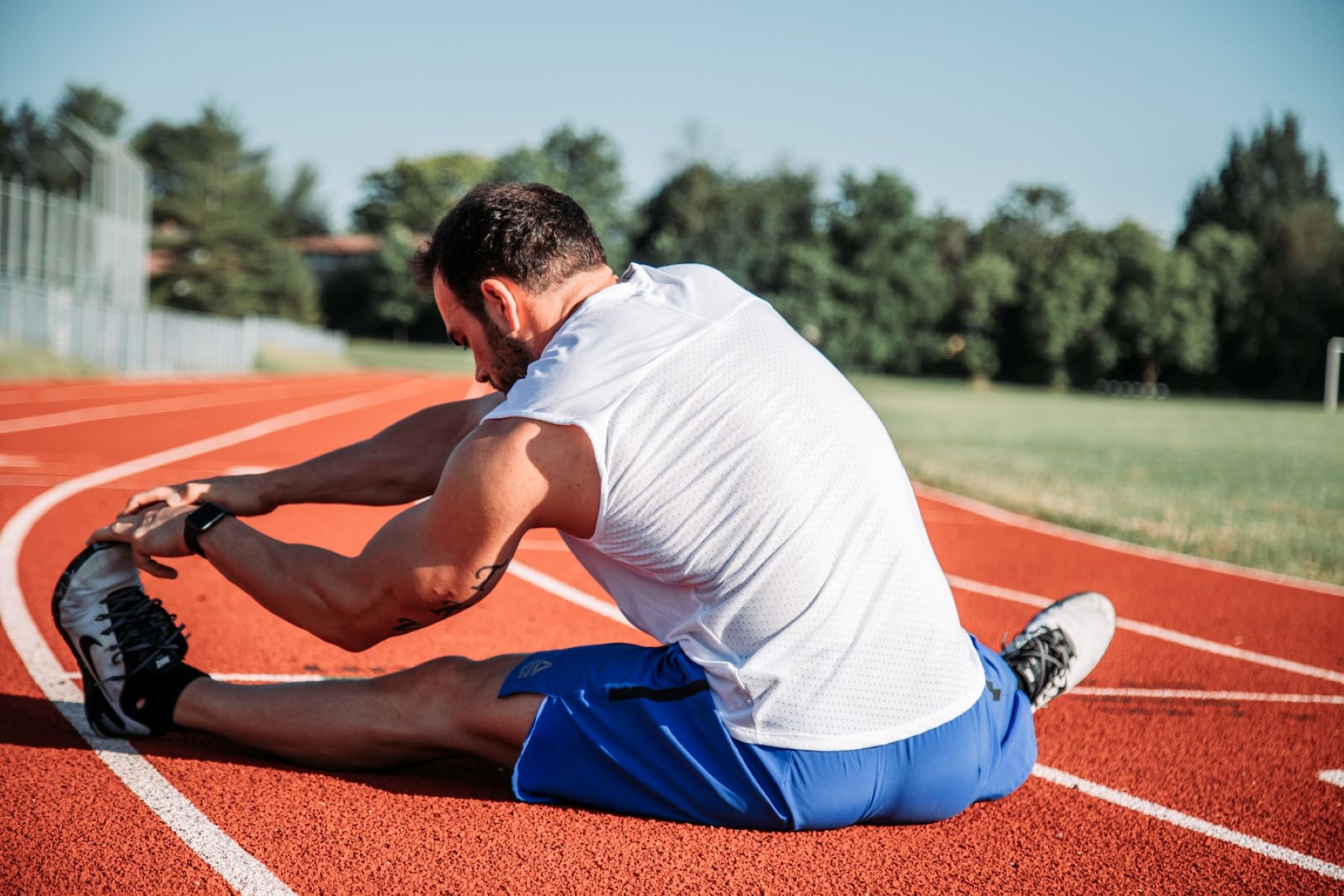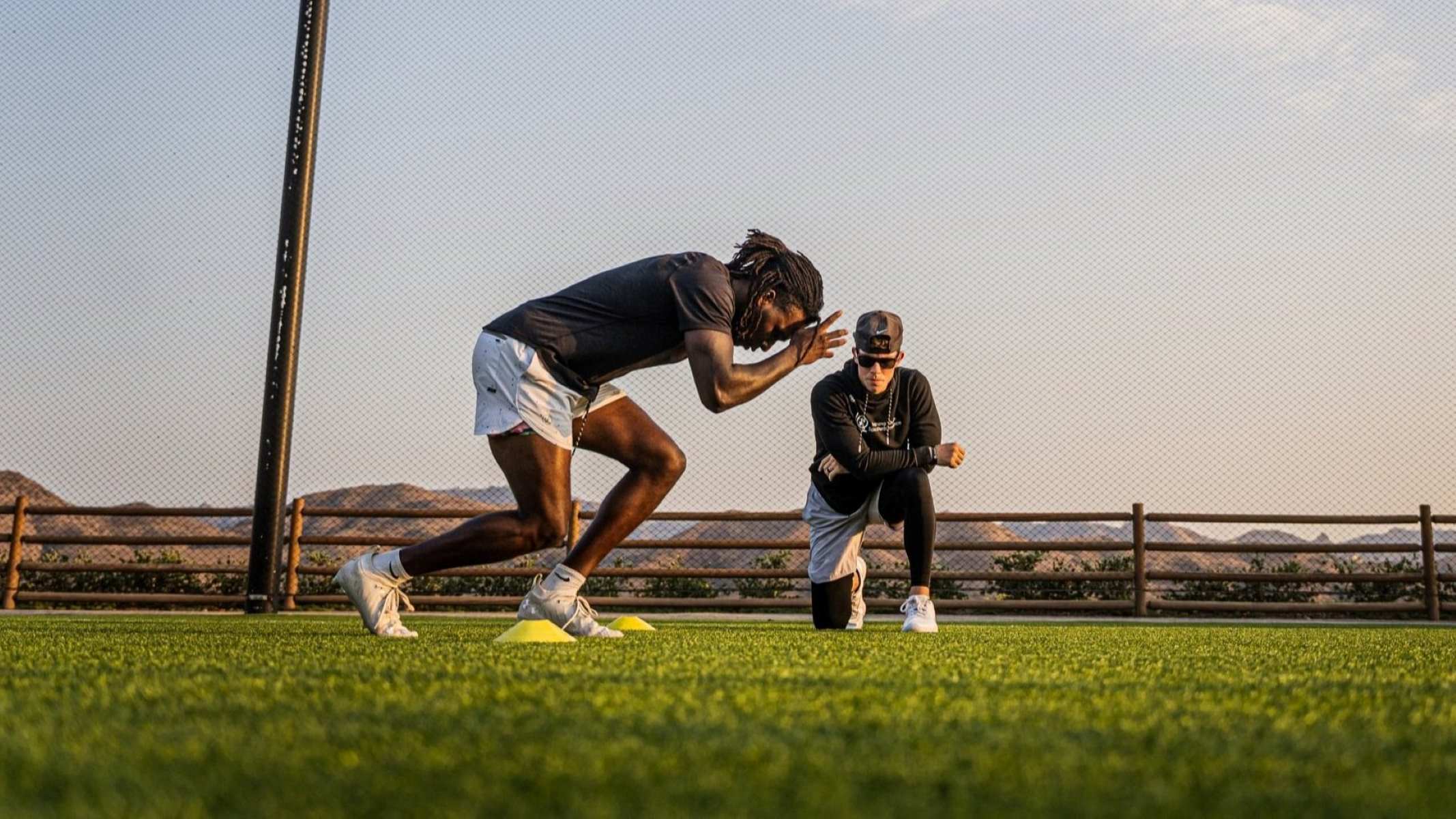Home>Misc>Featured>How Does Stretching Affect Athletic Performance?


Featured
How Does Stretching Affect Athletic Performance?
Modified: August 19, 2023
Learn how stretching can impact athletic performance and why it is featured as a key element in improving overall fitness and preventing injuries.
Introduction
Athletic performance is a culmination of various factors, including strength, speed, agility, and endurance. But one aspect that is often overlooked is the role of stretching in improving athletic performance. Stretching is not just a warm-up routine or something done after a workout; it plays a crucial role in preparing the body for physical exertion and preventing injuries.
Stretching involves the deliberate lengthening and stretching of muscles and tendons to improve joint range of motion. While its benefits are well-known among athletes and fitness enthusiasts, the science behind why stretching enhances athletic performance is often misunderstood.
In this article, we will explore the different types of stretching and their impact on athletic performance. We will also delve into how stretching affects muscle performance, injury prevention, muscle soreness, and flexibility. By understanding the relationship between stretching and athletic performance, you can optimize your training routine and unlock your full potential as an athlete.
Before we dive into the specifics, it’s important to note that different types of stretching have varying effects on the body. Dynamic stretching, static stretching, and proprioceptive neuromuscular facilitation (PNF) stretching are three common techniques employed in athletic training. Each type of stretching has its own benefits and implications for athletic performance.
Benefits of Stretching for Athletic Performance
Stretching offers a multitude of benefits that can directly enhance athletic performance. These benefits include improved flexibility, increased range of motion, enhanced muscular coordination, and improved circulation. Let’s take a closer look at how stretching can positively impact athletes:
- Improved Flexibility: Flexibility is the ability of muscles and joints to move freely through their full range of motion. By regularly incorporating stretching into your training routine, you can improve your flexibility, allowing you to achieve optimal body positioning during movements. Increased flexibility can also help decrease the risk of muscle imbalances and injuries.
- Increased Range of Motion: Range of motion (ROM) refers to the distance and direction a joint can move. Stretching helps to improve ROM by lengthening and loosening the muscles and tendons around the joints. This increased ROM allows for more fluid and efficient movements, which can translate to improved athletic performance in sports that require a wide range of motion, such as gymnastics or martial arts.
- Enhanced Muscular Coordination: Stretching stimulates the nervous system, increasing communication between your muscles and brain. This improved muscular coordination allows for more precise and controlled movements, leading to better performance in activities that require balance, agility, and coordination.
- Improved Circulation: Stretching promotes blood flow to the muscles, delivering essential nutrients and oxygen while removing waste products. This increased circulation can help optimize muscle function and reduce muscle fatigue during physical activity, ultimately improving endurance and performance.
In addition to these physical benefits, stretching also provides mental benefits for athletes. It helps to promote relaxation and reduce muscle tension, allowing athletes to focus on their performance without unnecessary distractions. Stretching can also serve as a pre-competition routine, helping athletes to mentally prepare and enter a state of readiness.
By incorporating stretching into your training routine, you can unlock your body’s full potential, improve your athletic performance, and reduce the risk of injuries. However, it is essential to choose the right type of stretching for your specific sport or activity, as different types have different effects on the body. In the following sections, we will explore dynamic stretching, static stretching, and proprioceptive neuromuscular facilitation (PNF) stretching and how each type can contribute to athletic performance.
Types of Stretching
Stretching is not a one-size-fits-all approach. There are various types of stretching techniques, each with its own purpose and benefits. Understanding the different types of stretching can help athletes determine which technique is most appropriate for their specific needs. The three most common types of stretching include dynamic stretching, static stretching, and proprioceptive neuromuscular facilitation (PNF) stretching.
- Dynamic Stretching: Dynamic stretching involves moving parts of your body through a full range of motion. It is characterized by controlled movements that mimic those of your sport or activity. Dynamic stretches are typically performed in a rhythmic and repetitive manner. Examples of dynamic stretching include walking lunges, arm circles, and leg swings. Dynamic stretching is often used as a warm-up before physical activity as it helps increase body temperature, improve blood flow, and activate the muscles that will be used during the activity.
- Static Stretching: Static stretching involves holding a stretch position for a prolonged period, typically between 15 and 60 seconds. This type of stretching aims to elongate and relax muscles, increasing flexibility and joint range of motion. Static stretches are performed in a stationary position without any movement. Examples of static stretching include toe touches, seated hamstring stretches, and quadriceps stretches.
- Proprioceptive Neuromuscular Facilitation (PNF) Stretching: PNF stretching involves a combination of stretching and contracting muscles. It is often performed with a partner or using a resistance band. PNF stretching techniques aim to improve flexibility and strength simultaneously by utilizing neuromuscular reflexes. One common PNF stretching technique is the contract-relax method, where the muscle is stretched, then contracted against resistance, and finally relaxed to achieve a deeper stretch. PNF stretching can be highly effective in improving flexibility and increasing range of motion.
Each type of stretching has its own benefits and implications for athletic performance. Dynamic stretching is ideal for warming up the body and preparing the muscles for activity. Static stretching is best suited for improving flexibility and joint range of motion. PNF stretching is a more advanced technique that can be used to target specific muscle groups and enhance both flexibility and strength. It is important to consider your specific sport or activity, as well as your individual needs and goals, when choosing the appropriate type of stretching.
Now that we have explored the different types of stretching, the next sections will investigate how each type of stretching impacts athletic performance.
Dynamic Stretching and Athletic Performance
Dynamic stretching is a type of stretching that involves moving parts of your body through a full range of motion. It is characterized by controlled movements that mimic those of your sport or activity. Dynamic stretching is commonly used as a warm-up before physical activity to prepare the muscles, increase body temperature, and improve blood flow. This type of stretching can have significant benefits for athletic performance.
One of the key advantages of dynamic stretching is that it helps activate the muscles and nervous system, priming the body for the specific movements and demands of your sport. By engaging in dynamic stretches that replicate the motions involved in your activity, you can effectively warm up the muscles and joints, enhancing their performance during the actual exercise or competition.
Dynamic stretching not only increases flexibility but also improves muscular power and strength. By dynamically moving through a range of motion, the muscles are stimulated and activated, leading to improved contractile function. This can result in increased explosive power, speed, and agility, which are crucial for many sports such as sprinting, jumping, and change of direction movements.
Furthermore, dynamic stretching helps improve joint mobility and stability. By moving through a controlled range of motion, the joints are lubricated, and synovial fluid is distributed evenly, resulting in improved joint health and function. This can help reduce the risk of injuries, especially in sports that require quick changes in direction or sudden stops.
It is important to note that the intensity and duration of dynamic stretches should be appropriate for your fitness level and sport. The focus should be on smooth and controlled movements rather than bouncing or jerking actions, which can lead to injury. Additionally, dynamic stretching should be tailored to the specific movements and muscle groups used in your sport to optimize its effectiveness.
Incorporating dynamic stretching into your warm-up routine can have a profound impact on your athletic performance. By priming the muscles and joints, improving flexibility, and enhancing power and strength, dynamic stretching sets the foundation for optimal performance. It is a valuable tool for athletes of all levels, from beginners to professionals, and should be an integral part of any training regimen.
In the next section, we will explore the benefits and implications of static stretching for athletic performance.
Static Stretching and Athletic Performance
Static stretching is a type of stretching that involves holding a stretch position for a prolonged period, typically between 15 and 60 seconds. It is often performed in a stationary position without any movement. While dynamic stretching is commonly used as a warm-up, static stretching is typically performed after a workout or physical activity to improve flexibility and help the muscles cool down.
Static stretching can have several benefits for athletic performance, especially in terms of improving flexibility and joint range of motion. By holding a stretch, the muscles and tendons are gradually lengthened, allowing for increased muscle elasticity. This increased flexibility can be particularly beneficial for athletes participating in sports that require a wide range of motion, such as martial arts, dance, or gymnastics.
One of the key advantages of static stretching is its ability to promote relaxation and reduce muscle tension. After an intense workout or physical activity, the muscles can become tight and fatigued. Static stretching helps to alleviate muscle tightness by elongating and relaxing the muscles, enhancing overall muscle recovery. This can result in reduced muscle soreness and improved muscle performance in subsequent workouts or competitions.
While static stretching is effective for improving flexibility, it is important to note that it should be performed with caution and at the appropriate time. Static stretching should generally be done after a proper warm-up or physical activity when the muscles are already warm. Engaging in static stretches with cold muscles can lead to decreased muscle performance and an increased risk of injury. It is also essential to avoid overstretching and holding the stretches beyond a comfortable range, as this can strain the muscles and potentially cause injury.
Additionally, static stretching may not be as beneficial for activities that require explosive power and quick muscle contractions, such as sprinting or weightlifting. Some studies suggest that static stretching before these types of activities can temporarily reduce muscle strength and power output. However, incorporating static stretching as part of a cool-down routine after such activities can still be beneficial for overall flexibility and recovery.
In summary, static stretching is a valuable component of an athlete’s training routine, particularly for improving flexibility and aiding in muscle recovery. By promoting relaxation, reducing muscle tension, and increasing joint range of motion, static stretching can contribute to better overall performance. However, it is essential to perform static stretches at the appropriate time and avoid overstretching to minimize the risk of injury and optimize its benefits.
Next, we will explore the benefits and implications of proprioceptive neuromuscular facilitation (PNF) stretching for athletic performance.
Proprioceptive Neuromuscular Facilitation (PNF) Stretching and Athletic Performance
Proprioceptive Neuromuscular Facilitation (PNF) stretching is a highly effective technique that combines stretching and contracting muscles to improve flexibility and strength. It is often performed with a partner or using a resistance band. PNF stretching aims to enhance both flexibility and muscular coordination, making it a valuable tool for athletes looking to improve their athletic performance.
One of the key benefits of PNF stretching is its ability to increase flexibility rapidly. By engaging in specific stretching techniques involving muscle contraction and relaxation, PNF stretching can help override the body’s natural stretch reflex and allow for greater muscle elongation. This can result in improved joint range of motion and enhanced overall flexibility, which is crucial for athletes participating in activities that require a high degree of mobility.
PNF stretching also has a notable impact on strength and muscular coordination. By combining stretching and contracting muscles against resistance, PNF stretching stimulates the neuromuscular system, enhancing communication between the muscles and the brain. This neuromuscular activation can lead to improved muscular coordination, stability, and strength, which are vital for athletic performance in sports such as weightlifting, gymnastics, and martial arts.
Another advantage of PNF stretching is its versatility and adaptability. Unlike other stretching techniques, PNF stretching allows for targeted and specific stretching of individual muscle groups or muscle chains. This precision targeting can help address specific flexibility imbalances, muscle tightness, or weakness that may be hindering optimal athletic performance. Athletes can work with a partner or a qualified professional to perform PNF stretching techniques tailored to their specific needs and goals.
While PNF stretching has numerous benefits, it is important to approach it with caution and learn the proper techniques from a qualified instructor. PNF stretching involves both stretching and muscle contractions, which require proper form and technique to avoid injury. It is essential to gradually ease into PNF stretches and follow the guidance of a trained professional to ensure the correct execution of the movements.
Incorporating PNF stretching into your training routine can significantly improve flexibility, strength, and muscular coordination, ultimately enhancing athletic performance. By targeting specific muscle groups and addressing flexibility imbalances, PNF stretching can optimize muscle function and reduce the risk of injuries. However, like any stretching method, it is crucial to perform PNF stretching with proper supervision and ensure that it complements your overall training program.
Now that we have explored the different types of stretching and their impact on athletic performance, we will further delve into the effects of stretching on muscle performance in the next section.
The Effects of Stretching on Muscle Performance
Stretching plays a vital role in the overall performance and function of muscles. It can have both immediate and long-term effects on muscle performance, including muscle strength, power output, and muscle endurance. Understanding these effects can help athletes optimize their training programs and achieve their performance goals.
One of the immediate effects of stretching on muscle performance is the temporary reduction in muscle strength and power output. Static stretching, in particular, has been shown to decrease muscle force production and power for a short period after stretching. This reduction in muscle performance is thought to be due to the relaxation of muscle-tendon units and a decrease in muscle stiffness. Therefore, it is recommended to avoid static stretching immediately before activities that require explosive power, such as sprinting or weightlifting.
On the other hand, dynamic stretching has been found to have minimal negative effects on muscle strength and power. In fact, dynamic stretching can help activate the muscles and prepare them for the specific movements of the activity, leading to improved muscle contractile function and power. This makes dynamic stretching a more suitable option for warm-ups before activities that require explosive movements.
While stretching may briefly reduce immediate muscle performance, it can have long-term benefits for muscle endurance and flexibility. Regular stretching routines, such as static or PNF stretching, can improve muscle elasticity and flexibility over time. This increased flexibility allows muscles to tolerate greater stretch without injury and can help improve muscle endurance by delaying the onset of muscle fatigue.
Stretching also plays a crucial role in promoting muscle recovery and preventing muscle imbalances and injuries. Stretching helps relieve muscle tension and reduce post-exercise soreness, facilitating the recovery process. Additionally, regular stretching can help correct muscle imbalances by targeting specific muscle groups and promoting balanced flexibility throughout the body. This can help reduce the risk of overuse injuries and optimize muscle function.
It is important to note that the effects of stretching on muscle performance can vary depending on individual factors such as age, fitness level, and training background. Different athletes may respond differently to various stretching techniques, and it is crucial to adapt the stretching routine to individual needs and goals.
In summary, while stretching may temporarily reduce muscle strength and power immediately after stretching, it can have positive long-term effects on muscle endurance, flexibility, and recovery. By incorporating dynamic stretching as part of a warm-up routine and static or PNF stretching for improving flexibility and preventing muscle imbalances, athletes can optimize their muscle performance and reduce the risk of injuries.
Next, we will explore the relationship between stretching and injury prevention in athletic performance.
Stretching and Injury Prevention
Injury prevention is a top priority for athletes, and stretching plays a crucial role in keeping the body resilient and reducing the risk of injuries. Proper stretching routines can help prepare the muscles and joints for physical activity, improve flexibility, and address muscle imbalances, all of which contribute to injury prevention.
One of the primary benefits of stretching in injury prevention is its ability to improve flexibility and joint range of motion. By regularly stretching the muscles and tendons, athletes can enhance their overall flexibility and reduce the likelihood of muscle strains, sprains, and joint injuries. Improved flexibility allows the body to move more freely and with better alignment, reducing the stress placed on muscles and joints during physical activity.
Stretching also helps address muscle imbalances, which can be a significant contributing factor to injuries. Muscle imbalances occur when certain muscles are stronger or tighter than others, causing an imbalance in muscular support and stability. This imbalance can lead to incorrect movement patterns and increased strain on certain muscles and joints, increasing the risk of injuries. By targeting specific muscle groups with stretching exercises, athletes can correct imbalances, improve muscle symmetry, and reduce the risk of overuse injuries.
Furthermore, stretching promotes proper muscle activation and coordination. When muscles are properly stretched and warmed up, they are more responsive and can better perform their intended functions. This improved muscular activation and coordination can help maintain proper body alignment, absorb and transfer forces more efficiently, and reduce the likelihood of biomechanical issues that can result in injuries.
While stretching is an effective tool for injury prevention, it is important to note that it is just one component of a comprehensive injury prevention program. Other factors, such as proper conditioning, strength training, and rest and recovery, are also crucial for minimizing the risk of injuries. In combination with these elements, stretching can significantly contribute to reducing the likelihood of sports-related injuries.
It is important to note that while stretching can help prevent certain types of injuries, it may not be effective for all injuries. For example, stretching alone may not prevent acute trauma injuries, such as fractures or direct impacts. It is crucial for athletes to receive proper guidance and conduct a comprehensive injury prevention program tailored to their specific sport or activity.
By incorporating stretching exercises into your regular training routine, you can enhance your flexibility, correct muscle imbalances, improve muscle activation, and reduce the risk of injuries. However, it is important to perform the stretches correctly, avoid overstretching, and listen to your body to prevent any potential injuries that could arise from improper stretching techniques or excessive force.
In the next section, we will explore the role of stretching in reducing muscle soreness after intense physical activity.
Stretching and Muscle Soreness
Muscle soreness is a common occurrence after intense physical activity, and stretching can play a beneficial role in reducing this post-exercise muscle soreness. While stretching alone may not completely prevent muscle soreness, it can help alleviate discomfort and aid in the recovery process.
Stretching after exercise helps to promote blood flow to the muscles and assist in the removal of metabolic waste products, such as lactic acid. This increased blood circulation helps to expedite the healing and recovery process, ultimately reducing muscle soreness. Stretching also helps to relax and lengthen the muscles, which can alleviate tension and tightness that contribute to muscle soreness.
Incorporating static stretching into your post-exercise routine can be particularly effective in reducing muscle soreness. By holding a stretch position, you allow the muscles to relax and elongate, minimizing post-exercise muscle tightness. Static stretching helps to release muscle tension and improve muscle recovery, making it valuable for athletes seeking relief from muscle soreness.
It is important to note that stretching should be performed safely and gently, especially when muscles are already fatigued from exercise. Stretching with excessive force or bouncing movements can increase the risk of injury or further muscle damage. It is best to hold stretches for a moderate amount of time, around 15 to 60 seconds, and avoid overstretching to prevent any potential muscle strains or injuries.
While stretching can help reduce muscle soreness, it is not the sole solution. Other recovery strategies such as proper hydration, adequate rest, and nutrition play equally important roles in minimizing muscle soreness and promoting overall recovery. Additionally, engaging in a gradual progression of exercise intensity and incorporating rest days into your training routine can help prevent excessive muscle soreness.
It is worth noting that dynamic stretching performed as part of a warm-up routine may also help reduce muscle soreness. Dynamic stretching increases blood flow, warms up the muscles, and prepares them for the demands of the activity. This can help prevent muscle stiffness and soreness typically experienced after intense workouts or athletic competitions.
In summary, while stretching may not completely prevent muscle soreness, it can be a valuable tool in alleviating discomfort and promoting muscle recovery. By incorporating post-exercise stretching into your routine, you can improve blood circulation, relax muscles, and reduce muscle tension, ultimately reducing the severity and duration of muscle soreness. Remember to stretch gently and safely, and complement your stretching routine with other recovery strategies for optimal results.
In the next section, we will explore the relationship between stretching and flexibility, and how it can impact athletic performance.
Stretching and Flexibility
Flexibility plays a crucial role in athletic performance, and stretching is a key component in improving and maintaining flexibility. Stretching helps to increase the range of motion of joints and muscles, ultimately enhancing athletic performance in various activities and reducing the risk of injuries.
Regular stretching exercises, such as static, dynamic, and PNF stretching, can improve overall flexibility. Static stretching, where a stretch is held for a prolonged period, helps to lengthen and relax muscles, which promotes flexibility and joint range of motion. Dynamic stretching, on the other hand, involves moving through a full range of motion, and it can improve dynamic flexibility, especially for sports that require explosive movements. PNF stretching, with its combination of stretching and muscle contraction, can further increase flexibility and improve muscle coordination.
Having good flexibility allows athletes to achieve proper body alignment, minimize energy expenditure, and optimize movement efficiency. A wider range of motion allows muscles and joints to work more effectively, leading to improved performance in activities such as running, jumping, and throwing. For example, a sprinter with increased hip flexibility can have a longer stride length and an improved running form, resulting in enhanced speed and efficiency.
Flexibility also plays a crucial role in injury prevention. When muscles and tendons are flexible, they are less likely to become strained or torn during physical activities. Improved flexibility can help absorb impact forces, reduce joint stress, and minimize the risk of muscle imbalances that can lead to injuries. It is important to note that flexibility imbalances, where some muscles are tighter or more flexible than others, can contribute to faulty movement patterns and increase the risk of injuries. Regular stretching can help address flexibility imbalances and promote balanced muscle development.
While flexibility is important, it is equally essential to note that excessive flexibility without adequate strength can also lead to instability and potential injuries. Therefore, a balance between flexibility and strength is crucial for optimal athletic performance. Incorporating strength training exercises alongside stretching routines can help maintain this balance and promote proper muscle function.
It is important to approach stretching with caution and gradually work towards increasing flexibility. It takes time and consistency to improve flexibility, and overstretching or pushing too hard can result in muscle strains or joint instability. It is best to listen to your body, perform stretches within a comfortable range, and work with a qualified professional to ensure correct technique and execution.
In summary, stretching is a key tool for improving flexibility, and flexibility plays a vital role in athletic performance and injury prevention. Regular stretching exercises, customized to individual needs and goals, can help increase joint range of motion, optimize movement efficiency, and reduce the risk of muscle imbalances and injuries. The combination of flexibility and strength provides a solid foundation for athletes to perform at their best and minimize the risk of sports-related injuries.
In the final section, we will wrap up the main points discussed in this article and emphasize the importance of incorporating stretching into an athlete’s training routine.
Conclusion
Stretching is a critical component of an athlete’s training routine, with far-reaching effects on athletic performance. By incorporating the right types of stretching techniques, athletes can reap a multitude of benefits, including improved flexibility, increased range of motion, enhanced muscular coordination, and improved circulation. Furthermore, stretching plays a crucial role in injury prevention by promoting muscle balance, reducing muscle soreness, and improving muscle recovery.
Dynamic stretching is particularly effective as a warm-up routine, activating the muscles and preparing them for specific movements during an activity. It improves flexibility, muscular power, and joint mobility, making it ideal for sports that require explosive movements. Static stretching, on the other hand, is more effective when performed after exercise to improve overall flexibility, relax muscles, and aid in recovery. PNF stretching combines stretching and muscle contraction to enhance flexibility and strength simultaneously, making it a valuable technique for athletes.
While stretching has numerous benefits, it is important to approach it with caution and ensure proper technique to prevent injuries. Stretching should be tailored to an individual’s needs, goals, and the demands of their specific sport or activity. Stretching alone cannot guarantee injury prevention, as it should be combined with other elements such as conditioning, strength training, adequate rest, and nutrition for optimal results.
By incorporating stretching into their training routines, athletes can optimize their performance, reduce the risk of injuries, and improve overall muscle health. It is advisable to work with a qualified professional to develop a well-rounded stretching program that suits individual needs and goals. Regular stretching, when done correctly and consistently, can unlock an athlete’s full potential, allowing them to excel in their chosen sport or activity.






